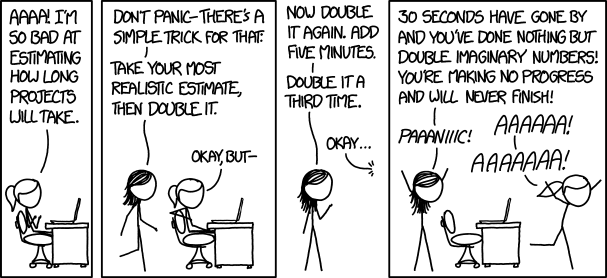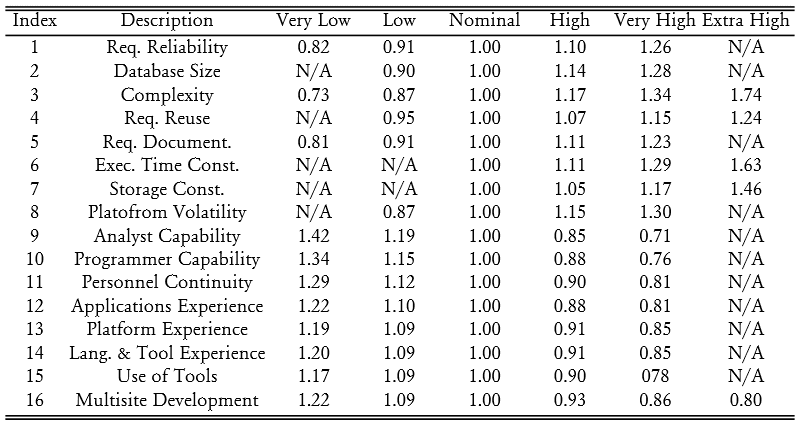Software Estimation
An Introduction
|
|
Prof. David Bernstein
James Madison University
|
|
| Computer Science Department |
| bernstdh@jmu.edu |

|
Motivation
- Some Common Planning Tasks:
- Required Information:
- Time estimates (perhaps by task)
- Cost estimates
- Some Perspective (Standish, 2001; Kidder 1981)
- 63% of successful software development projects are
late
- 45% of successful software development projects are
over budget
Nerd Humor

(Courtesy of xkcd)
Using Historical Data
- Scope:
- Industry-standard vs. organization-specific
- Nature of the Data:
- Qualitative (small, medium, large) vs. quantitative
(LOC or FP)
- Modeling Technique:
- Formal (e.g., use
regression analysis
to estimate parameters of the model from the data) vs. informal
(e.g., identify rules-of-thumb)
An Example - Organization-Specific, Quantitative, Informal
- Background Information:
- Function points for earlier products
- A rule-of-thumb about organization-specific productivity
in function points per person-months (e.g., 5 FP/pm)
- Labor cost in dollars per person-month (e.g., $12,000/pm)
- Information about the Product:
- Constructing a Point Estimate:
- Effort: \(E = 425 / 5 = 85\)pm
- Cost: \(C = 85 \cdot 12000 = 1020000\)dollars
An Example - Industry-Standard, Quantitative, Formal
- KLOC-Based (\(L\)) Log-Linear:
- Walston and Felix (1977): \(E = 5.2 L^{0.91}\)
- Basili and Freburger (1981): \(E = 1.38 L^{0.93}\)
- Boehm (1981): \(E = 3.2 L^{1.05}\)
- FP-Based (\(F\)) Linear:
- Albrecht and Gaffney (1983): \(E = -91.4 + 0.255 F\)
- Kemerer (1987): \(E = -37.0 + 0.96 F\)
- (Note that the negative \(y\)-intercept means
that these models are not appropriate for small values
of \(F\).)
An Example - Organization-Specific, Qualitative, Formal
- Data Collection (Humphrey, 1995):
- Classify features from other products as very small,
small, medium, large, and very large
- Collect data from other products on LOC per feature
(if done correctly, categories should vary by at least a
factor of 2)
- Estimation:
- Classify required features
- Count the features in each classification
- Multiply
- Add
Some Common Models
- The Software Equation:
- \(E\) (effort) is a function of \(t\)
(project duration) and \(L\) (KLOC)
- COCOMO II:
- \(E\) is a function of \(L\), \(F\)
(function points), or object points
- International Software Benchmarking Standards Group:
- \(E\) is a function of \(F\)
and \(N\) (team size) with specific parameters for
different physical architectures and languages
The Software Equation (Putnam and Meyers, 1992)
- Additional Notation:
- \(t\) denotes the project duration
- \(B\) denotes a "special skills factor"
(\(B\) is 0.16 for products with fewer than
15 KLOC and increases to 0.39 for products with more than
70 KLOC)
- \(p\) denotes a "productivity factor" that
reflects the process and practices, experience, and
product complexity (e.g., 2000 for real-time embedded
software, 12000 for scientific software)
- The Two-Variable (\(L\) and \(t\)) Model:
-
\(E = \frac{L \cdot B^{1/3}}{p^3} \cdot \frac{1}{t^4}
\)
- The One variable Model:
-
\(t = 8.14 \frac{L}{p^{0.43}}\)
-
\(E = 180 B \left(\frac{t}{12}\right)^{3}\)
COCOMO II - Constructive Cost Model (Boehm, 1981/2000)
- Collection of Models:
- Pre-Requirements (Application Composition)
- Stabilized Requirements (Early Design)
- Construction (Post-Architecture)
- Alternative Size Measures:
- Lines of Code
- Function Points
- Object Points
- Factors to Consider:
- Scale factors
- Product factors
- Platform factors
- Personnel factors
- Project factors
COCOMO II (cont.)
- Nominal Effort:
- \(E = 2.94 \cdot L^\beta \cdot \prod_{i=1}^{16} W_i\)
- where \(W_i\) is an effort multiplier,
\(\beta = 0.91 + 0.01 \cdot \sum_{j=1}^{5} \Psi_j\),
and \(\Psi_j\) is a scale factor
- The Scale Factors (\(\Psi_j\)):
- Effort Multipliers (\(W_i\)):
International Software Benchmarking Standards Group (2005)
- Additional Notation:
- \(N\) denotes the (maximum) team size
- A General Model:
- \(E = 0.512 \cdot F^{0.392} \cdot N^{0.791}\)
- Other Models:
- They have estimated the parameters of this model for
products for mainframes, mid-range systems, desktops
- They have estimated the parameters of this model for
different kinds of languages


